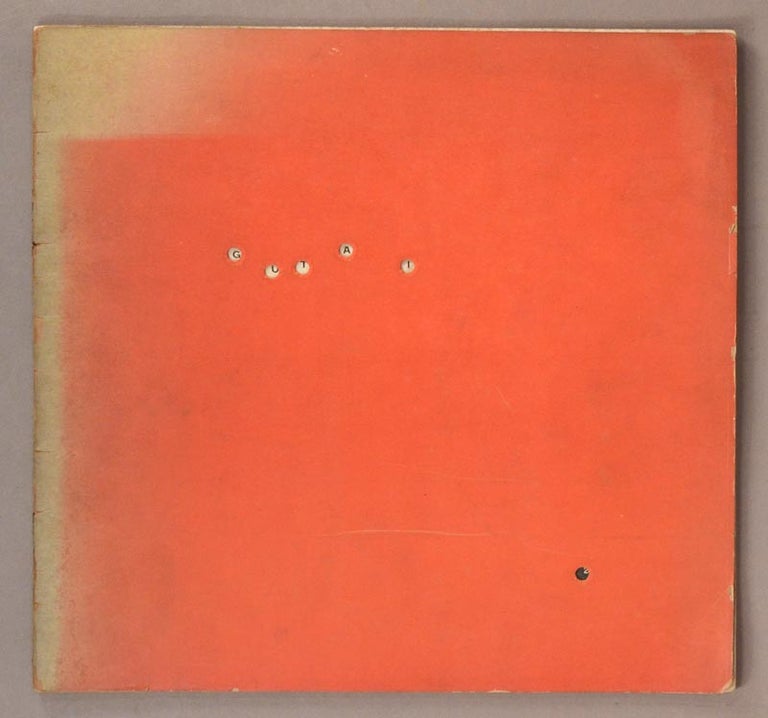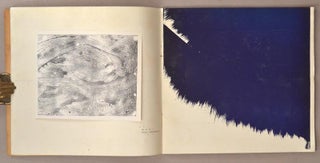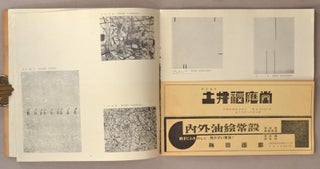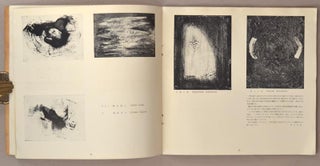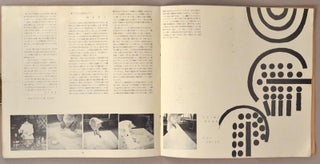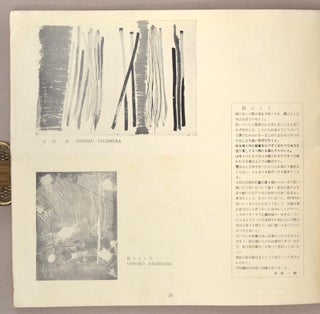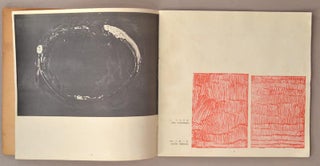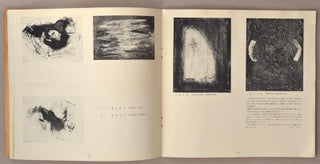Gutai 2 具体 2
1995. Item #90977
Gutai 2 具体 2 - Kinoshita Toshiko Inui Michiko no Sakuhin 木下淑子 乾美地子の作品 [Special Collection: The Works Of Kinoshita Toshiko and Inui Michiko]
Gutai Bijutsu Kyōkai 具体美術協会
Yoshihara Jirō 吉原次郎, editor
Nishinomiya 西宮
Showa 30, October 10, 1955
25.7 x 27.2cm magazine with [30 pp] of black and white and color reproduced photographs of artwork and Japanese and English text. Covers are orange-red with gradation from tan at binding. Five small, round punched holes reveal the letters that spell out “Gutai” with a sixth hole in the lower right revealing the issue number “2.” Pagination begins with the cover; the tan subscription card inserts with ads are counted within the pagination. A list on the initial page with artists and colophon is in Japanese and English. There are three tipped-in images; one reproduced image that was tipped-in on page 7 is missing.
It is interesting that they made a special effort to identify this second issue of the GUTAI journal with KinoshitaToshiko 木下淑子 (1928-?) and Inui Michiko 乾美地子 (1942-?). Three pages are devoted to the paintings of Inui, who was, surprisingly, only thirteen years old at the time, and had also been featured in the children’s magazine Kirin. Kinoshita’s work is featured as two tipped-in color images. The artists whose work is depicted in the journal are Yoshihara Jiro, Shiraga Kazuo, Shimamoto Shozo, Tanaka Atsuko, Yoshihara Michio, Ono Itoko, Kanayama Akira, Sumi Yasuo, Sekine Yoshio, Masanobu Masatoshi, Murakami Saburo, Kinoshita Toshiko, Sugimura Shigeru, Hashigami Yoshiko, Uemae Chiyu, Okada Hiroshi and Inui Michiko. In addition, there are a number of short essays by the artists themselves and others about the works. There is a long essay in English by Yozo Ukita entitled, “Documentary on the Second Edition of “GUTAI” on p. 30. At the end, he suggests: “‘GUTAI’ might be literary [sic] translated as ‘Embodiment.’”
Gutai was a radical post-war art movement that preceded performance art in the US by a decade. The Gutai Art Association ( Gutai Bijutsu Kyokai) or Gutai Group was formed in 1954 by Yoshihara and Shimamoto Shozo (1928 - 2013) and was active until 1972. The physical nature of their art (gutai roughly translates to "embodiment" or "the concrete") resulted in kinetic paintings, 3-dimensional sculptures and performances. Audiences came to expect the unexpected. A Gutai Group artist might burst through hanging sheets of paper, paint with his feet while swinging on ropes or wrestle with the paints directly on the canvas, pushing the boundaries of the avant-garde Mavo movement that preceded it. At times the audience was encouraged to join in and create the art with markers on an unfinished canvas or buttons that chimed musical notes.
The Gutai magazine was an important method of recording the group's art and concepts and extending to audiences abroad. One of those whom the magazine reached was Michel Tapié (1909 - 1987), a French critic and collector. Tapié was a supporter of what he called "L'art informel" (Art Informel); encompassing international art that transcended what was then categorized as modern. He was a great promoter of The Gutai Group, and it was believed he found them through this periodical.
Internationally recognized for their contribution to modern art, Gutai artists's works are held in the Guggenheim Museum, Tate Modern, Tate Gallery, and MOMA, as well as other institutions in Japan and abroad.
Staples are oxidized, small nicks at binding and front cover edge, starting at top binding. Foxing on inside front covers, end pages and backing of middle pages. Musty scent.
Price: $2,000.00

